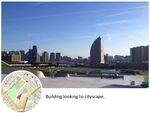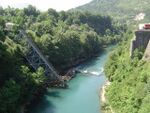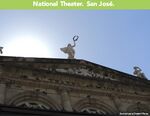LED Online Seminar 2018 - Working Group 1
--> Back to working group overview
Dear working group members. This is your group page and you will be completing the template gradually as we move through the seminar. Good luck and enjoy your collaboration!
Assignment 1 - Reading and Synthesizing Core Terminology
- You can read more details about this assignment here
- Readings are accessible via the resources page
Step 1: Your Landscape Democracy Manifestoes
Step 2: Define your readings
- Please add your readings selection for the terminology exercise before April 18:
A: Landscape and Democracy
Kucan, Ana (2007). Constructing Landscape Conceptions (Salma Malak Bennasser)
Burckhardt, Lucius (1979): Why is landscape beautiful? in: Fezer/Schmitz (Eds.) Rethinking Man-made Environments (2012) (Laura Chaverri Flores)
B: Concepts of Participation
Day, Christopher (2002): Consensus Design, Architectural Press (Irma Karic) Sanoff, Henry (2014): Multiple Views of Participatory Design (Salma Malak Bennasser)
Hester, Randolph (2012): Evaluating Community Design, Landscape Journal (Laura Chaverri Flores)
C: Community and Identity
Welk Von Mossner, Alexa (2014): Cinematic Landscapes, In: Topos, No. 88, 2014 (Irma Karic)
D: Designing
Smith, Nicola Dawn(2012): Design Charrette: A Vehicle for Consultation or Collaboration (Irma Karic) Hester, Randolph: Democratic Drawing - Techniques for Participatory Design (Salma Malak Bennasser)
Hester, Randolph: Life, Liberty and the Pursuit of Sustainable Happiness (Laura Chaverri Flores)
E: Communicating a Vision
Steps 3 and 4: Concepts Selection and definition
- Each group member selects three relevant concepts derived from his/her readings and synthesize them/publish them on the wiki by May 9, 2018
- Group members reflect within their groups and define their chosen concepts into a shared definition to be posted on the wiki by June 6, 2018.
- Other group members will be able to comment on the definitions until June 12, 2018
- Each group will also report on their process to come to a set of shared definitions of key landscape democracy concepts on the wiki documentation until June 20, 2018
Concepts and definitions
Author 1: ...
- ......
- .......
- .......
Author 2: ...
- ......
- .......
- .......
Author 3: ...
- ......
- .......
- .......
Author 4: ...
- ......
- .......
- .......
Author 5: ...
- ......
- .......
- .......
Step 5: Reflection
Step 6: Revised manifestoes
- please look again at your initial manifestoes and update them with any new aspects/prespectives you have taken up during this seminar
Assignment 2 - Your Landscape Symbols
- You can read more details about this assignment here
Landscape Symbols Author 1: Rashad Gasimov
Landscape Symbols Author 2: Irma Karic
The important landscape symbol of small town Jablanica (B&H) with great historical value reminding on one of the most famous battles from WWII - Battle of Neretva. The bridge was destroyed three times: once as a ruse, then in an actual attack while Partisans were defending themselves from the Axis forces coming from the eastern bank of Neretva river, and finally for the movie. The addition to this historical remaining is Neretva river, the natural landmark of Herzegovina.
Center of the old town of Sarajevo - Baščaršija, is a monument of historical period of Bosnia being part of Ottoman Empire. This part of the city is known as commercial area where people would/are selling their hand-made products. It is one of the most important touristic attractions in the city. Baščaršija is symbol of time, oriental architecture and preserved traditional crafts.
Landscape Symbols Auther 3: Abhishek Passan
Lake Pichola, Udaipur is an artificial lake constructed in 1362 AD. It is one of the contiguous lake for Udaipur city as it was meant to meet the water for varied uses and was constructed by creating dams so as to store the rain water as to majorly serve the drinking needs as well as for the irrigation purpose. It also has four islands to it with varied landuses to them. But the current scenario has totally changed as now it serves as a commercial and recreational area for the users and is a major tourist destination. The environmental conditions of the lake are in grave danger because of which deterioration has been caused to the aquatic life as well as to the quality of water. It not only represents to the landscape symbol but is a prime node today as well as in earlier days was used by the Kings for recreational purpose thus granting it a historic as well as religiously important.Co-ordinates : 24° 34′ 19.2″ N, 73° 40′ 44.4″ E
City Palace, Udaipur is a palace complex and was constructed in 1553 with a time span of around 400 Years. It is a true symbol of power and dominance as it depicts the heritage, tradition and culture prevailing in the area. Now, one of the major tourist destinations used to be the residence of the royal family as well as is a symbol of strength and flamboyant environment for the city.Co-ordiantes: 24.576°N 73.683°E
Skyline, Udaipur. It depicts the natural undulations in the city surrounded by many landscape symbols such as hills, lakes and many other natural and man-made features thus making it a vibrant city and also imparting heritage value to the place. These features are the key landscape symbols to make the area more vibrant and habitable.
Landscape Symbols Author 4: Laura Chaverri Flores
The U-suré, conical house or cosmic house, is impregnated with symbolism and has faced different use changes over time. Before the arrival of Europeans in Costa Rica was used as a traditional house. The roof is a large cone that represents a celestial vault. After independence, the Ministry of Health prohibited the Indigenous people to use their traditional house as a home, they were inserting western houses in these communities. In this way, the U-suré became a traditional and sacred space and a house of culture. It is believed that there is another identical cone that grows below the ground, where the 4 virtual underworlds are located. Suita palm is used for it construction so the house is biodegradable and every 12 years is rebuilt in a collective ceremony, at the end of the construction there take place a community celebration. There is at least one U-suré in any bribri community. The picture shows Cachabri´s U-suré cultural house, in Talamanca at the east of the country. Today this symbol means identity that reminds us of a large portion of our indigenous history that is constantly invisible from Eurocentric hegemonic discourses.
The construction of the National Theater began in 1891 and was inaugurated in 1897, in San José city. It was promoted by the coffee oligarchy that had political power at that time. The intention was to have a European-style theater that would serve as amusement place for the bourgeoisie of the time. At that time, a series of national buildings were created to build a nationalist identity based on the Europeanization of the Costa Rican people. This is why the National Theater style is german neo-clasical. There were exclusively Europeans shows, such as operas and classical music concerts. At that time, the theater was the most expensive and hierarchical building in San José and was a symbol of "culture" and development. Today this building does not stop having iconic prominence. Its use has been democratized promoting free shows and diverse cultural activities such as popular dance and Costa Rican music. However, it remains a symbol of power that many Costa Ricans with low incomes do not know inside. I think the symbolic hierarchy can be very understandable to any citizen who knows Western culture.
Guayabo National Monument was an ancient indigenous city populated from 1000 before Christ to 1400 after Christ, located in Turrialba. According to the latest research the city was abandoned before the arrival of the Spaniards. The city was strategically located in a Valley, between two rivers with a visual finish to another very important natural symbol, the Turrialba volcano. Guayabo was buried for a long time, until several archaeologists rediscovered it. In 1973 it began with the recovery of the site that was declared, at that time, National Monument, becoming the largest archaeological site in the country. In 2009 it was declared a World Heritage Site due to the complexity of its aqueducts. In addition, nowadays a remnant of evergreen pre-montane rainforest is protected. This site is still part of the identity of the Costa Rican and although it is no longer used as a city but as a place to visit, it can help us understand how a pre-Columbian city worked in our territory. Although today conical houses cannot be seen because of their biodegradable condition, it is possible to imagine them and go back in time to visualize the city in its splendor.
Landscape Symbols Author 5: Salma Malak Bennasser
Agadir Oufela:Hill with an inscription using painted stones meaning:«God, Country, King». The inscription found in many other hills around the country, represents a symbol of solidarity between the king and the people under one religion.Its summit is occupied by the ruins of the ancient fortress which was build in 1572 and that was destroyed due to the earthquake in 1960. The hill holds the original name and the history of the city « Agadir ». [1]
The wall of commemoration or remembrance: Wall ingraved in Arabic calligraphy with a quote from King Mohammad V:«Fate may have decided to destroy Agadir, but its reconstruction depends on our faith and will». It is dedicated to the victims of the 1960 earthquake. While the clear message of the quote is the faith and determination to rebuild the city but also the solidarity with the families of the victims, the wall symbolizes an important religious belief of most Moroccan people, which is to accept destiny and never lose hope as things get better after difficult times.[2]
Argan tree: An endemic tree to Morocco growing between safi and the fringes of the Sahara. It is a centenary tree that can live up to 200 years. It can grow in extreme conditions of soil and drought and it help fight against soil erosion and desertification. Argan oil, known as « the Moroccan oil » outside of the country, is extracted from the kernel of its fruit and is used for its cosmetic propreties. It is used to combat the aging and the drying of the skin, for softer and stronger hair and to strengthen breaking nails. It is considered the only source of income for some people living in remote and arid areas. For those reasons it can be considered the national symbol of resistance and strength as well as the symbol of youth and beauty. [3]
Assignment 3 - Role Play on Landscape Democracy "movers and shakers"
- You can read more details about this assignment here
Assignment 4 - Your Landscape Democracy Challenge
- You can read more details about this assignment here
- Each group member will specify a landscape democracy challenge in his/her environment
Landscape Democracy Challenge 1
- Give a title to your challenge
- Yourname challenge 1.jpg
caption: why did you select this case?
- Yourname challenge 2.jpg
caption: what is the issue/conflict (1)
- Yourname challenge 3.jpg
caption: what is the issue/conflict (2)
- Yourname challenge 4.jpg
caption: who are the actors?
Your references:
- ...
- ...
Landscape Democracy Challenge 2
- Give a title to your challenge
- Yourname challenge 1.jpg
caption: why did you select this case?
- Yourname challenge 2.jpg
caption: what is the issue/conflict (1)
- Yourname challenge 3.jpg
caption: what is the issue/conflict (2)
- Yourname challenge 4.jpg
caption: who are the actors?
Your references:
- ...
- ...
Landscape Democracy Challenge 3
- Give a title to your challenge
- Yourname challenge 1.jpg
caption: why did you select this case?
- Yourname challenge 2.jpg
caption: what is the issue/conflict (1)
- Yourname challenge 3.jpg
caption: what is the issue/conflict (2)
- Yourname challenge 4.jpg
caption: who are the actors?
Your references:
- ...
- ...
Landscape Democracy Challenge 4
- Give a title to your challenge
- Yourname challenge 1.jpg
caption: why did you select this case?
- Yourname challenge 2.jpg
caption: what is the issue/conflict (1)
- Yourname challenge 3.jpg
caption: what is the issue/conflict (2)
- Yourname challenge 4.jpg
caption: who are the actors?
Your references:
- ...
- ...
Landscape Democracy Challenge 5
- Give a title to your challenge
- Yourname challenge 1.jpg
caption: why did you select this case?
- Yourname challenge 2.jpg
caption: what is the issue/conflict (1)
- Yourname challenge 3.jpg
caption: what is the issue/conflict (2)
- Yourname challenge 4.jpg
caption: who are the actors?
Your references:
- ...
- ...
Assignment 5 - Your Democratic Change Process
- You can read more details about this assignment here
- After documenting and reflecting on your challenges you will continue jointly with one of these challenges and design a democratic change process
Your Democratic Change Process
- Add Title
- Your Democratic Change Process Slide1.jpg
caption: ...
- Your Democratic Change Process Slide2.jpg
caption: ...
- Your Democratic Change Process Slide3.jpg
caption: ...
- Your Democratic Change Process Slide4.jpg
caption: ...
Reflection
- ....
- ....
- ....
Conclusion:
- ....
- ....
- ....
Your references
- ...
- ...
- ...


















![Agadir Oufela:Hill with an inscription using painted stones meaning:«God, Country, King». The inscription found in many other hills around the country, represents a symbol of solidarity between the king and the people under one religion.Its summit is occupied by the ruins of the ancient fortress which was build in 1572 and that was destroyed due to the earthquake in 1960. The hill holds the original name and the history of the city « Agadir ». [1]](/images/thumb/8/86/Agadir_oufela.jpg/150px-Agadir_oufela.jpg)
![The wall of commemoration or remembrance: Wall ingraved in Arabic calligraphy with a quote from King Mohammad V:«Fate may have decided to destroy Agadir, but its reconstruction depends on our faith and will». It is dedicated to the victims of the 1960 earthquake. While the clear message of the quote is the faith and determination to rebuild the city but also the solidarity with the families of the victims, the wall symbolizes an important religious belief of most Moroccan people, which is to accept destiny and never lose hope as things get better after difficult times.[2]](/images/thumb/e/e1/The_wall_of_commemoration.jpg/150px-The_wall_of_commemoration.jpg)
![Argan tree: An endemic tree to Morocco growing between safi and the fringes of the Sahara. It is a centenary tree that can live up to 200 years. It can grow in extreme conditions of soil and drought and it help fight against soil erosion and desertification. Argan oil, known as « the Moroccan oil » outside of the country, is extracted from the kernel of its fruit and is used for its cosmetic propreties. It is used to combat the aging and the drying of the skin, for softer and stronger hair and to strengthen breaking nails. It is considered the only source of income for some people living in remote and arid areas. For those reasons it can be considered the national symbol of resistance and strength as well as the symbol of youth and beauty. [3]](/images/thumb/e/ef/Argania_spinosa.jpg/150px-Argania_spinosa.jpg)